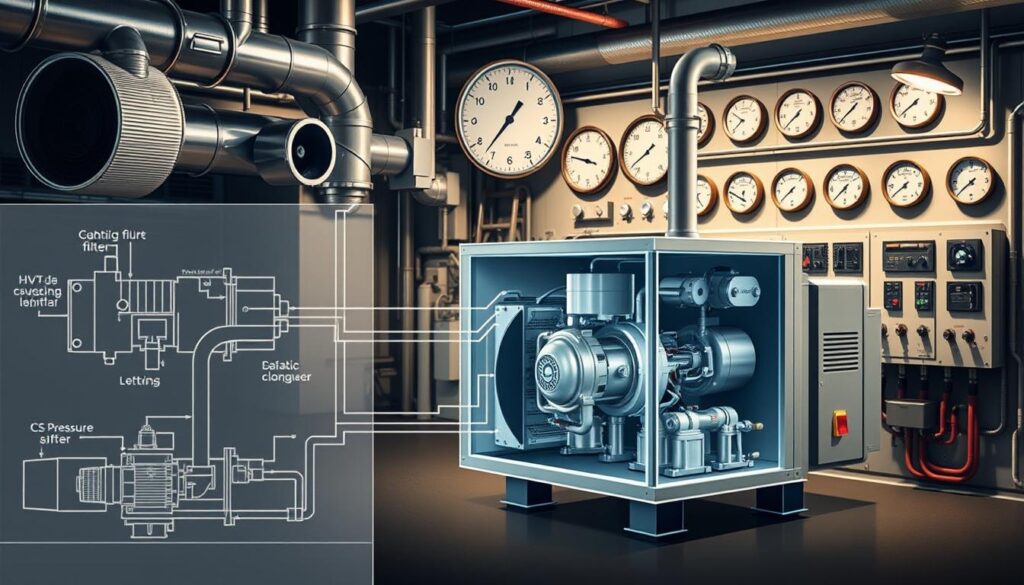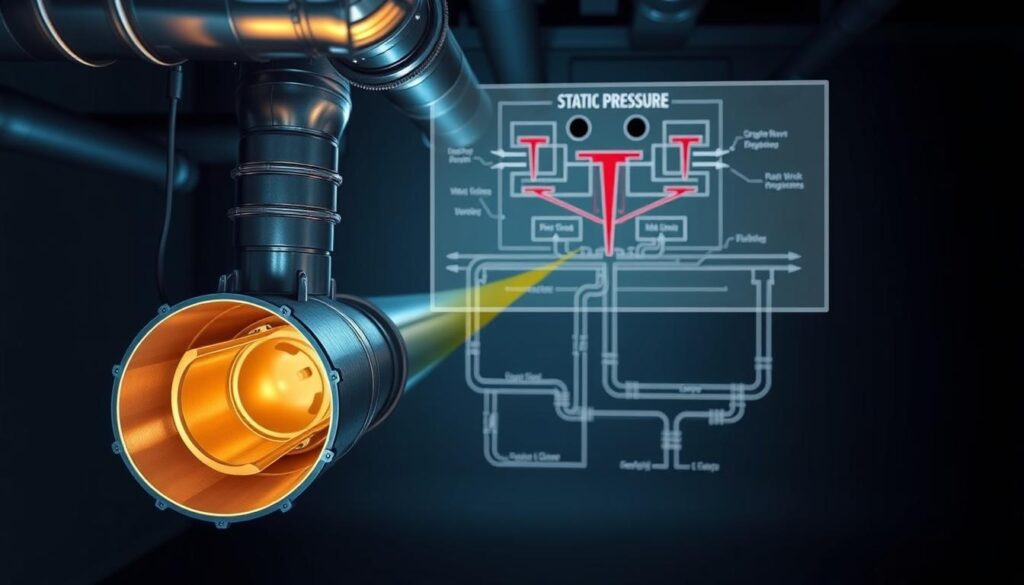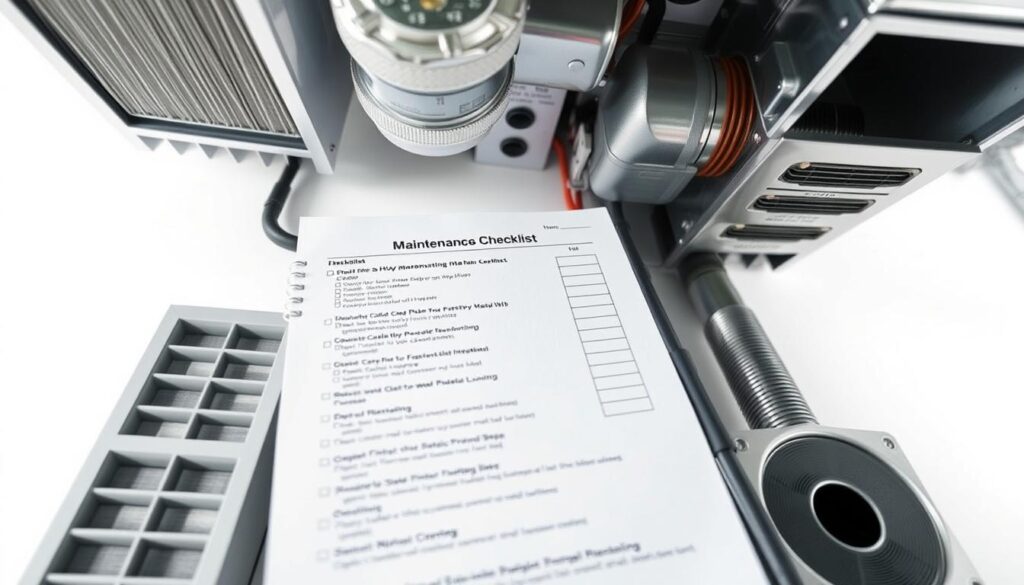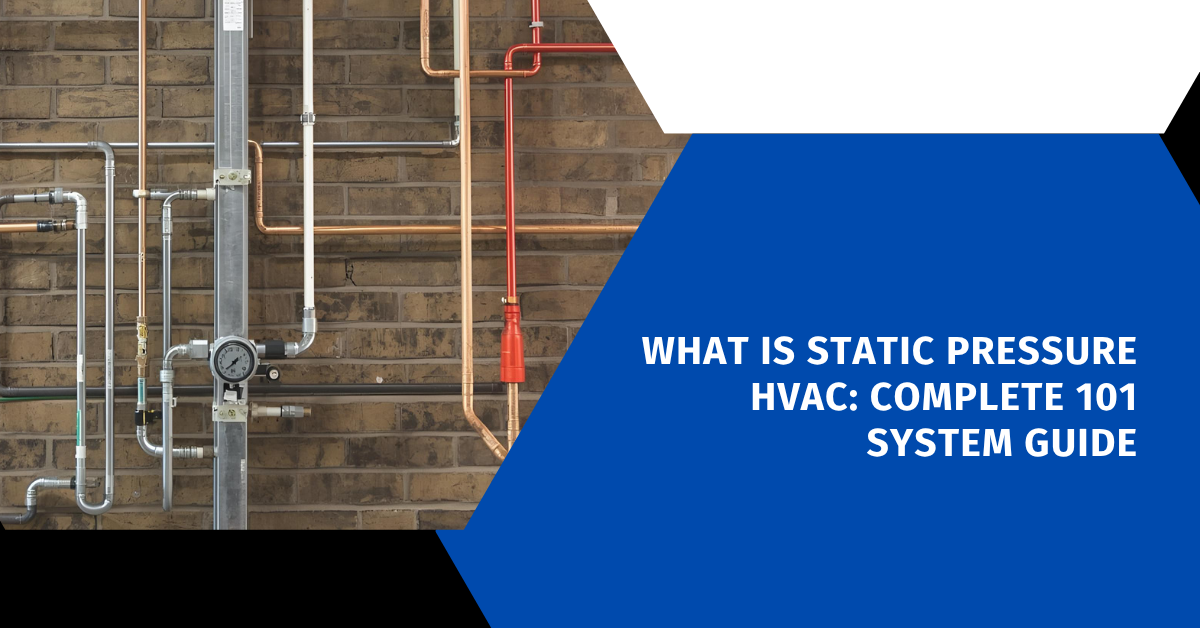Affiliate Disclosure
HVAC Guide Guys is a participant in the Amazon Services LLC Associates Program, an affiliate advertising program designed to provide a means for sites to earn advertising fees by advertising and linking to Amazon.
What Is Static Pressure HVAC? Ever wondered why your home’s heating and cooling system can’t keep the temperature right? It might be because of static pressure in HVAC systems.

Knowing about static pressure in air conditioning is key to a comfy home. It shows how hard air has to push through your ducts. This affects your HVAC system’s performance.
Too much or too little static pressure makes your system work too hard. This can lead to poor performance, higher energy bills, and even damage to your equipment.
Key Takeaways
- Static pressure measures airflow resistance in HVAC systems
- Proper static pressure ensures optimal system performance
- Imbalanced pressure can cause comfort and efficiency problems
- Professional assessment helps diagnose static pressure issues
- Regular maintenance prevents long-term HVAC system complications
Table of Contents
Understanding Static Pressure in HVAC Systems
Static pressure is key in air conditioning. It affects how well your system works and how efficient it is. Knowing about static pressure is vital for keeping your HVAC system running smoothly.
Your HVAC system is like a network of airways. Air flows through ducts like water through pipes. The resistance to this flow is what we call static pressure. It’s a major factor in your system’s performance.
Basic Principles of Air Resistance
Air resistance in HVAC systems is like water in a hose. When you block the hose, water pressure goes up and it moves faster. This idea is true for static vs dynamic pressure in HVAC systems:
- Narrow ducts cause more air resistance
- More resistance means higher static pressure
- Less airflow hurts your system’s performance
The Role of Static Pressure in HVAC Performance
Your HVAC system’s efficiency depends on balanced static pressure. If it’s too high or too low, you’ll face big problems. These include:
- Less airflow
- More energy use
- Uneven temperatures
Static vs Dynamic Pressure Explained
Static pressure is about air pressure in stationary ducts. Dynamic pressure is about moving air. Static pressure is like stored energy, while dynamic pressure is the energy of moving air.
Managing static pressure well means your HVAC system works best.
What Is Static Pressure HVAC and Why It Matters
Static pressure in HVAC systems is key to how well your heating and cooling work. Knowing about static pressure in HVAC helps keep your system running right. It also stops problems before they start.
Static pressure is like your HVAC system’s blood pressure. It shows how hard air has to push through ducts and equipment. If the pressure is off, your system can’t move air well.
- The ideal static pressure is 0.5 inches of water column
- Proper levels ensure maximum system efficiency
- Incorrect pressure can lead to increased energy consumption
Keeping the right static pressure is very important. High pressure makes your system work too hard. This leads to:
- Higher energy bills
- Shorter equipment life
- Uneven temperatures
- System failures
Maintaining optimal static pressure is like keeping your HVAC system in peak athletic condition.
Regular checks and maintenance help manage static pressure. This keeps your HVAC system running well, saving energy and money.
Common Signs of Static Pressure Problems
Your HVAC system gives you clues about its health. Knowing these signs can help you spot static pressure issues early. These problems can quietly harm your system’s performance and efficiency.
It’s important to recognize signs of static pressure problems. This helps keep your home comfortable and your system running well for longer. Here are the main warning signs:
Noisy System Operation
An HVAC system that’s too loud is not just annoying. Whistling, rattling, or loud whooshing sounds often mean high static pressure. When air flow is blocked, your system works harder, making strange noises.
Uneven Temperature Distribution
Do you see big temperature differences in your home? Static pressure problems can cause:
- Hot and cold spots throughout your home
- Inconsistent cooling or heating
- Rooms that never seem to reach the desired temperature
Increased Energy Bills
Higher energy bills might mean static pressure issues. When your HVAC system fights air resistance, it uses more electricity. Watching your utility bills can help spot these problems early.
Spotting these signs early can save you a lot of money on repairs. It also improves your HVAC system’s performance.
Explore Our HVAC Shop
Looking for top-rated HVAC tools, parts, and accessories? Visit our shop and find the perfect solution for your needs.
Visit the ShopMeasuring and Testing Static Pressure
Knowing how to test static pressure is key to keeping your HVAC system running well. It helps spot problems early, before they get worse.
To do a static pressure test right, you need the right tools and a clear plan. Experts use digital manometers for exact readings. These tools check the air resistance in your system.
- Essential tools for hvac static pressure measurement:
- Digital manometer
- Pressure testing ports
- Protective safety equipment
Here’s how to test static pressure:
- Find the system’s supply and return air openings
- Drill small test ports into these spots
- Connect the digital manometer to each port
- Record the readings from both sides
- Add the positive readings to find the total static pressure
Pro tip: Always convert negative pressure readings to positive values for accurate assessment.
While some might try to test it themselves, experts say it’s best to have a pro do it. They know how to read complex pressure readings and suggest the right changes.
Optimal Static Pressure Levels for HVAC Systems
Knowing the right static pressure levels is key for your HVAC system’s health. The balance of your HVAC system relies on precise pressure control. This control affects how well your system works.
Static pressure is how hard air pushes through your ducts. Experts say keeping this pressure in certain ranges is vital for the best system performance.
Industry Standards and Recommendations
Getting the static pressure right is very important. HVAC pros usually follow these rules:
- Ideal static pressure range: 0.3 to 0.5 inches of water column
- Measurements above 0.5 inches show system problems
- Pressure should be the same in all system parts
Factors Affecting Pressure Readings
Many things can change your HVAC system’s static pressure:
| Factor | Impact on Static Pressure |
|---|---|
| Ductwork design | Directly affects air resistance and flow |
| Filter condition | Dirty filters make system harder to breathe |
| Equipment specifications | What the maker says is the best pressure |
Keeping the right static pressure means regular checks and expert care. Your HVAC system’s life and performance depend on good pressure control.
Impact of Ductwork Design on Static Pressure

Your HVAC system’s performance depends a lot on duct design and managing static pressure. Knowing how ductwork affects air flow can make your system work better and feel more comfortable.
Duct design is key to keeping static pressure just right. When you design your HVAC system’s ductwork, several important factors affect air flow and system balance:
- Duct sizing proportional to system capacity
- Minimizing unnecessary bends and restrictions
- Selecting appropriate materials for airflow
- Ensuring proper sealing and insulation
There’s a general rule for duct design. It says a one-ton air conditioning unit fits about 500 square feet of space. This helps keep static pressure balanced and avoids airflow problems.
Badly sized or shaped ductwork can really mess with your HVAC system. Ducts that are too small limit airflow, making static pressure go up and forcing your system to work too hard. On the other hand, ducts that are too big can slow down air flow and make temperatures uneven.
Proper duct design is not just about size, but about creating an efficient pathway for air circulation.
To get your HVAC system running better, think about getting a professional ductwork check. Experts can look at your current setup, find any static pressure issues, and suggest the right changes to improve how your system works.
Explore Our HVAC Shop
Looking for top-rated HVAC tools, parts, and accessories? Visit our shop and find the perfect solution for your needs.
Visit the ShopStatic Pressure Problems and Solutions
When your HVAC system has static pressure problems, it’s key to know the causes and fixes. These issues can hurt your system’s performance, comfort, and energy use.
Finding solutions for static pressure problems needs a careful plan. Most problems come from specific issues that can be fixed with the right diagnosis and actions.
Common Causes of Pressure Issues
- Dirty or clogged air filters
- Blocked or restricted air vents
- Undersized or improperly designed ductwork
- Malfunctioning blower motors
- Excessive dust and debris accumulation
Professional Remediation Methods
Fixing static pressure problems often needs a pro. Certified HVAC techs can do detailed checks to find and fix specific problems.
| Problem | Professional Solution |
|---|---|
| Restricted Airflow | Ductwork redesign and optimization |
| Filter Blockage | Comprehensive system cleaning and filter replacement |
| Equipment Misalignment | Precise system calibration and component adjustment |
While some small issues can be fixed by you, big problems need a pro. Trying to fix complex issues yourself can harm your HVAC system and cost more to fix.
Getting regular checks from pros and doing upkeep can stop static pressure problems. This keeps your HVAC system running well.
Maintaining Proper Static Pressure
Keeping your HVAC system’s static pressure right is key to its performance and life span. The right static pressure is vital for your system’s efficiency and comfort. It’s something you can’t ignore.

Several maintenance steps are essential for your system’s balance. Regular care can avoid expensive fixes and keep your system running smoothly.
- Replace air filters every 1-3 months
- Inspect ductwork for leaks or damage quarterly
- Keep vents and registers clean and unobstructed
- Schedule professional HVAC maintenance annually
Here’s a detailed maintenance checklist to help you manage static pressure effectively:
| Maintenance Task | Frequency | Purpose |
|---|---|---|
| Air Filter Replacement | Every 1-3 months | Reduce system strain and maintain airflow |
| Ductwork Inspection | Quarterly | Identify and seal possible air leaks |
| Professional HVAC Check | Annually | Comprehensive system performance evaluation |
Look out for signs of static pressure problems. Signs include reduced airflow, strange noises, or uneven temperatures. These signs mean you need to act fast to keep your system balanced and efficient.
Proactive maintenance is key to preventing expensive HVAC repairs and ensuring optimal system performance.
Explore Our HVAC Shop
Looking for top-rated HVAC tools, parts, and accessories? Visit our shop and find the perfect solution for your needs.
Visit the ShopThe Relationship Between Static Pressure and System Efficiency
Understanding how static pressure affects your HVAC system is key. It helps keep your home comfortable and saves energy. A balanced HVAC system is essential for top performance and less energy waste.
Proper static pressure is very important. It makes your HVAC system work better and more efficiently.
Energy Consumption Factors
Several things affect how much energy your HVAC system uses:
- Ductwork design and configuration
- Air filter resistance
- Equipment age and maintenance
- Overall system airflow
Performance Optimization Techniques
To make your HVAC system more efficient, try these tips:
- Get regular professional static pressure tests
- Change air filters often
- Make sure ductwork is the right size
- Have annual HVAC maintenance
Managing static pressure well can save a lot of energy and make your home more comfortable.
A well-balanced HVAC system can cut energy use by up to 20% while keeping your home just right.
Conclusion
Learning about static pressure HVAC is key to a comfy and efficient home. Your HVAC system works best when air resistance and pressure are just right. This balance means better cooling and heating, lower bills, and steady indoor temps.
Ignoring static pressure can cause big problems. It can make your system work less well, raise your bills, and even harm your health. Knowing about static pressure helps you catch issues early, avoiding expensive fixes or new systems.
Experts say to check your HVAC system often to keep it running well. By doing maintenance and fixing pressure issues, you can make your system last longer. This also improves your air quality and makes your home more comfortable.
Don’t wait to get your HVAC system checked for static pressure. With the right steps, you can make your home’s heating and cooling better. This saves money and makes your home healthier.

